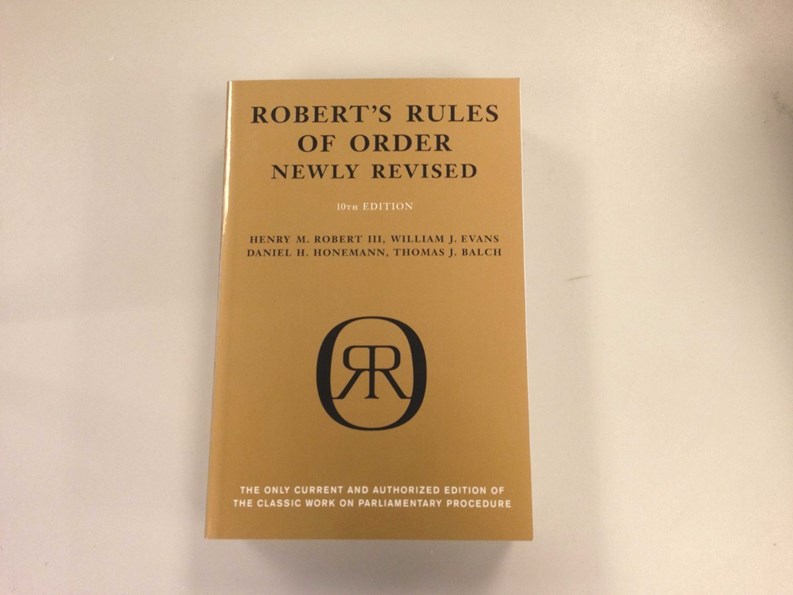Back in the late 1800’s, an army officer named Henry Martyn Robert wrote a distillation of Parliamentary Procedure (which was used by the American Congress at the time), to help people run smooth and effective meetings, whether it be a church, local government gathering, or other “deliberative societies.” Today, nearly every type of organization, from Fortune 500 companies to small-town PTAs, use Robert’s Rules of Orderto keep their meetings focused. They use the procedure because it works.
Though many co-op and condo boards of directors already use Robert’s Rules or some variation of them, many board members could help themselves by better understanding them. If they can grasp the procedures well, boards can apply them in a way that is more pertinent to their particular deliberations, simplifying the process while making it more effective.
Keeper of the Rules
Robert’s Rules of Order was created and became the Bible of meeting procedure almost by accident. Henry Martyn Robert was a general and engineering officer in the U.S. Army who was asked to preside over a public meeting in San Francisco. Only one problem: He didn’t know how to run a meeting. Still, he tried, and the meeting was chaos. The experience made him determined to learn about parliamentary law.
So he studied the few books available on the subject at that time. Because of his military duties, Robert was transferred to different parts of the United States, where he found meetings in anarchy, with each member having differing ideas of correct procedure. To bring sanity to these running meetings, he wrote Robert's Rules of Order, as it came to be called. First published in February 1876, the book’s original name was “Pocket Manual Rules Of Order For Deliberative Assemblies.”
Robert’s Rules have not changed drastically over the years but they have been repeatedly tweaked and explained, to help readers make the most of them. The book is in its eleventh edition (2011), and is still owned and run by the family, with 92-year-old Henry M. Robert III, of Annapolis, MD, at the helm of the enterprise. Growing up as the son of a Naval Academy professor, Henry III didn’t fully realize the import of the family legacy until he became involved in the family business in the 1950s. He is now the senior co-author of the last five editions of Robert’s Rules. But back when he was young, the “Rules” were a common topic of conversation around his house.
He grew up with his parents discussing parliamentary procedure at dinner, and at other times in daily life. “People would write in with questions on parliamentary procedure that weren’t described in the book, and my parents would discuss it,” Robert says.
The book has morphed over the generations, to keep up to date with the growth of parliamentary procedure. Uniquely, an authorial tie has linked the original author to the others who’ve contributed to the refinement of this best-loved manual of procedure. All editions of the work issued after the death of the original author have been prepared by persons who either knew and worked with the original author or are connected to such persons. Younger generations of the family are involved in keeping up the legacy, down to the fifth generation after Gen. Robert.
The various editions have expanded on the original book and made it more relevant, says Jeanette Williams, education director of the American Institute of Parliamentarians (AIP), a nationwide group based in Wilmington, DE. “When the book first was written, we didn’t have fax machines and telephones; and now the rules allow for the use of voting cards, rather than people standing up and sitting down [to vote],” she says.
But what is parliamentary procedure, and how is it applicable to a co-op or condo building board or shareholder meeting? Simply put, parliamentary procedure is how English-speaking people have been running meetings for hundreds of years, based partly upon how British Parliament works. Parliamentary procedure involves ground-rules that are so familiar to Americans that many of us don’t even realize that’s what they are—we just know how things work at the shareholders meeting or the school board meetings. Common practices like “yielding the floor” to the speaker—allowing a person to speak uninterrupted for a set time—are part of the procedure, which also governs how motions are brought to vote, how votes are taken, and other aspects of a meeting.
“Parliamentary procedure refers to the rules of democracy—that is, the commonly accepted way in which a group of people come together, present and discuss possible courses of action, and make decisions,” says the National Association of Parliamentarians website. “Parliamentary procedure defines how groups of people, no matter how formal or informal, can most effectively meet and make decisions in a fair, consistent manner—and make good use of everyone's time.”
Ordering Meetings
It’s hard to determine how many co-op/condo boards across the country use Robert’s Rules, but experts say the majority of such organizations probably do. The rules work to a large degree even if a board uses only parts of them—they can be tailored to fit each organization.
“I use a really modified, liberal type of Robert’s Rules,” says Warren Schreiber, president of Bay Terrace, in Queens. “I go into my board meetings with an agenda. I do want people recognized when they speak… When a motion is made, people only can discuss the motion itself.”
“Robert’s Rules are an important tool when they’re used properly, but if they’re too strict, it can be an impediment. Or if used too liberally, you can lose control of the meeting,” Schreiber says. “You want to have controlled chaos.”
Robert’s Rules are important because the book provides people with a guideline for the meeting. “You don’t have to follow it exactly, but it helps the meetings run more smoothly,” Schreiber says.
For example, according to Robert’s Rules, each member can speak twice for 10 minutes on each issue. But in a highly contentious board meeting in which 50 or more residents plan to speak, the time which each has the floor may be limited to just five minutes per member, in the interests of expediency. Nobody wants to be in a board meeting all night long.
The idea is to allow everybody to have his or her voice heard, but limits must be placed on the discussion. Parliamentary procedures are the procedural rules formally adopted by an assembly to help expedite business, Williams says. There are other rules by which boards can run meetings, but Robert’s Rules is the most commonly used.
“Several states, including NC, HI, OR, mandate the use of the latest edition of Robert’s Rules for board and membership meetings of HOA’s and condos,” says James Slaughter, a Charlotte, NC-based attorney specializing in co-op and condo law. “Such statutory language prescribing a parliamentary authority is likely to become more common. In other states, while no statute mandates any particular book, it is not uncommon to find Robert’s prescribed as the parliamentary authority in the governing documents of the association, most often the bylaws.”
But aside from expediency—a goal for meetings that is hard to argue with—what’s the benefit of using Robert’s Rules, as opposed to using a more informal approach to meetings and decision making?
“The Rules respond to a continuing need, having been found necessary by experience. If you get a group together trying to make decisions representing the collective agreement of the group, you’ll soon find you need rules to do it,” Robert says.
The procedure also helps people to feel more comfortable in working within such member-based organizations.
“People are more likely to volunteer for boards if they know business is conducted fairly and impartially,” Williams says.
Seeking Help
The best way for board members to adapt Robert’s Rules to better suit their needs is to start by learning the rules, Schreiber says. “There are a lot of places to do that. There have been so many books written that just deal with Robert’s Rules…. One of the problems with the Rules is that it also can be used by some to manipulate the meeting by making too many motions.”
Having the rulebook nearby in the event of a dispute during a meeting is a wise course. Boards can have the president of the board or another on the board ensure that he has a copy of Robert’s Rules, or one of the smaller handbooks on the rules, on hand during every meeting.
There are a variety of resources that board members and managers can turn to for help in implementing Robert’s Rules in their meetings. They can consult their attorney, who may or may not be well-versed in the Rules. Or, they can ask for the advice of a certified Professional Parliamentarian. A parliamentarian can help bring focus to an organization’s meetings, in a fair way that will appeal to all members.
In addition to consulting Robert’s Rules of Order, board members and residents have a lot of information available, including the book’s website, and the website of the American Institute of Parliamentarians, and other resources. Slaughter has two books on the topic that could be helpful to those who want to know more. The Complete Idiot’s Guide to Parliamentary Procedure Fast-Track is focused on smaller meetings, including boards of condominiums and HOA’s, and provides details on the most used motions, appropriate informal procedures for smaller boards, and advice for shortening meetings.
Notes and Comments of ‘Robert’s Rules,' Fourth Edition is a guide to the new 716-page edition of Robert’s Rules of Order Newly Revised, and is designed for more procedurally complicated meetings such as annual and special membership meetings. The book is designed to make Robert’s accessible, and uses a question-and-answer format to cover the most asked-about provisions.
For more information, visit www.robertsrules.com: The official website of Robert’s Rules, which is a strong resource for info on the history, purpose, and application of the Rules. Another source is parliametarians.org, the website of the National Association of Parliamentarians. Additionally, there are several articles on HOA/condo association procedure and procedural statutes on Slaughter’s website, www.jimslaughter.com.
Jonathan Barnes is a freelance writer and frequent contributor to The Cooperator.







Leave a Comment